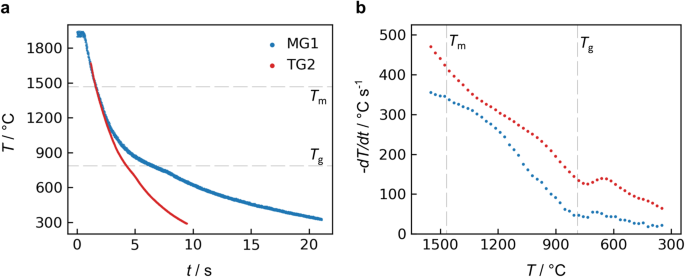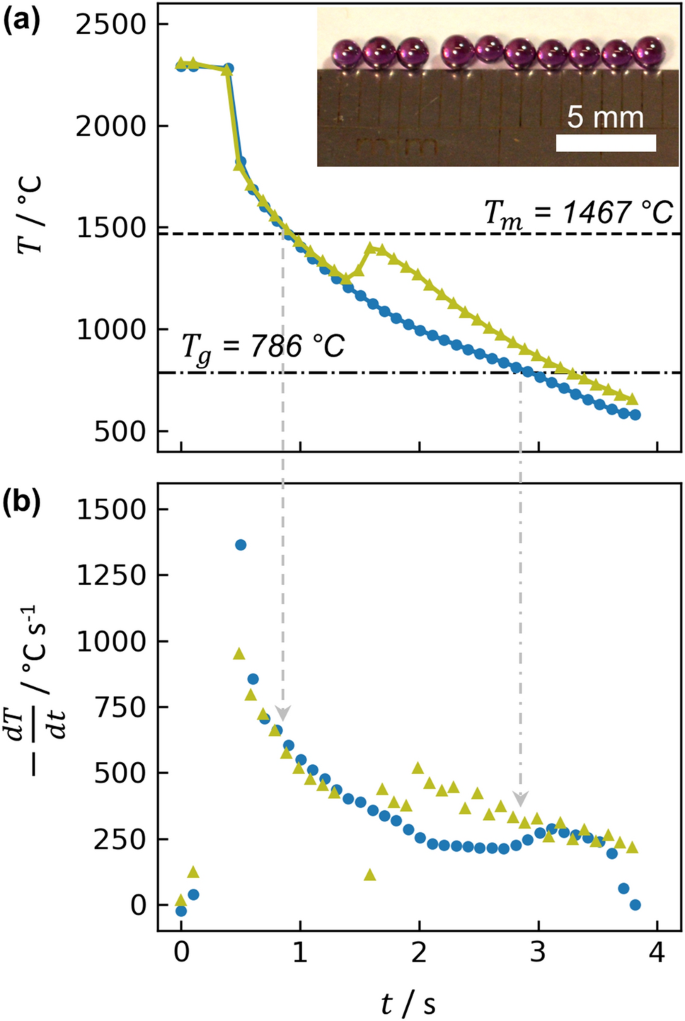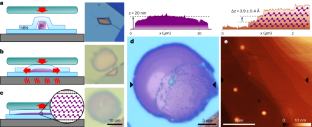2024-05-21 オークリッジ国立研究所(ORNL)
<関連情報>
- https://www.ornl.gov/news/neutrons-open-window-explore-space-glass
- https://www.nature.com/articles/s41526-024-00371-x
- https://www.nature.com/articles/s41598-022-12342-x
チタン酸ネオジムの非平衡溶融加工における微小重力効果:熱物性、原子構造、ガラス形成と結晶化 Microgravity effects on nonequilibrium melt processing of neodymium titanate: thermophysical properties, atomic structure, glass formation and crystallization
Stephen K. Wilke,Abdulrahman Al-Rubkhi,Chihiro Koyama,Takehiko Ishikawa,Hirohisa Oda,Brian Topper,Elizabeth M. Tsekrekas,Doris Möncke,Oliver L. G. Alderman,Vrishank Menon,Jared Rafferty,Emma Clark,Alan L. Kastengren,Chris J. Benmore,Jan Ilavsky,Jörg Neuefeind,Shinji Kohara,Michael SanSoucie,Brandon Phillips & Richard Weber
npj Microgravity Published:06 March 2024
DOI:https://doi.org/10.1038/s41526-024-00371-x

Abstract
The relationships between materials processing and structure can vary between terrestrial and reduced gravity environments. As one case study, we compare the nonequilibrium melt processing of a rare-earth titanate, nominally 83TiO2-17Nd2O3, and the structure of its glassy and crystalline products. Density and thermal expansion for the liquid, supercooled liquid, and glass are measured over 300–1850 °C using the Electrostatic Levitation Furnace (ELF) in microgravity, and two replicate density measurements were reproducible to within 0.4%. Cooling rates in ELF are 40–110 °C s−1 lower than those in a terrestrial aerodynamic levitator due to the absence of forced convection. X-ray/neutron total scattering and Raman spectroscopy indicate that glasses processed on Earth and in microgravity exhibit similar atomic structures, with only subtle differences that are consistent with compositional variations of ~2 mol. % Nd2O3. The glass atomic network contains a mixture of corner- and edge-sharing Ti-O polyhedra, and the fraction of edge-sharing arrangements decreases with increasing Nd2O3 content. X-ray tomography and electron microscopy of crystalline products reveal substantial differences in microstructure, grain size, and crystalline phases, which arise from differences in the melt processes.
常圧チタン酸ネオジムにおける八面体酸化物ガラスネットワーク Octahedral oxide glass network in ambient pressure neodymium titanate
Stephen K. Wilke,Oliver L. G. Alderman,Chris J. Benmore,Jörg Neuefeind & Richard Weber
Scientific Reports Published:18 May 2022
DOI:https://doi.org/10.1038/s41598-022-12342-x

Abstract
Rare-earth titanates form very fragile liquids that can be made into glasses with useful optical properties. We investigate the atomic structure of 83TiO2-17Nd2O3 glass using pair distribution function (PDF) analysis of X-ray and neutron diffraction with double isotope substitutions for both Ti and Nd. Six total structure factors are analyzed (5 neutron + 1 X-ray) to obtain complementary sensitivities to O and Ti/Nd scattering, and an empirical potential structure refinement (EPSR) provides a structural model consistent with the experimental measurements. Glass density is estimated as 4.72(13) g cm−3, consistent with direct measurements. The EPSR model indicates nearest neighbor interactions for Ti-O at ¯r = 1.984(11) Å with coordination of = 5.72(6) and for Nd-O at ¯r = 2.598(22) Å with coordination of = 7.70(26), in reasonable agreement with neutron first order difference functions for Ti and Nd. The titanate glass network comprises a mixture of distorted Ti-O5 and Ti-O6 polyhedra connected via 71% corner-sharing and 23% edge-sharing. The O-Ti coordination environments include 15% nonbridging O-Ti1, 51% bridging O-Ti2, and 32% tricluster O-Ti3. This structure is highly unusual for oxide glasses melt-quenched at ambient pressure, as it consists of Ti-Ox predominantly in octahedral (with nearly no tetrahedral) coordination.



